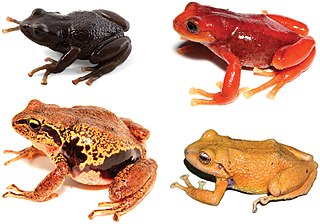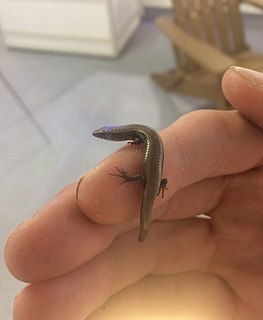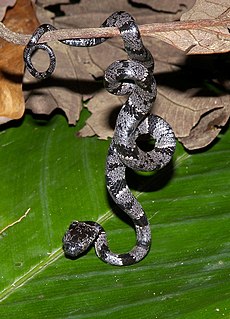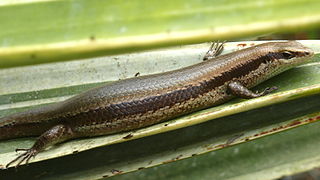
Phyllodactylus is a genus of geckos distributed in South America and Central America, and as far north as the southern United States. They are commonly known as "leaf-toed geckos" in their native range, and otherwise as American leaf-toed geckos to distinguish them from unrelated genera with similar feet.

Sphaerodactylus is a genus of geckos from the Americas that are distinguished from other Gekkota by their small size, by their round, rather than vertical, eye pupils, and by each digit terminating in a single, round adhesive pad or scale, from which their name is derived. All species in this genus are rather small, but two species, S. ariasae and S. parthenopion, are tiny, and – with a snout-vent length of about 1.6 cm (0.63 in) – the smallest reptiles in the world.

Spiny lizards is a common name for the genus Sceloporus in the family Phrynosomatidae. The genus is endemic to North America and Central America. This genus includes some of the most commonly seen lizards in the United States.

Mabuya is a genus of long-tailed skinks restricted to species from various Caribbean islands. They are primarily carnivorous, though many are omnivorous. The genus is viviparous, having a highly evolved placenta that resembles that of eutherian mammals. Formerly, many Old World species were placed here, as Mabuya was a kind of "wastebasket taxon". These Old World species are now placed in the genera Chioninia, Eutropis, and Trachylepis. Under the older classification, the New World species were referred to as "American mabuyas", and now include the genera Alinea, Aspronema, Brasiliscincus, Capitellum, Maracaiba, Marisora, Varzea, and Copeoglossum.

Craugastor is a large genus of frogs in the family Craugastoridae. It has over 110 species. Its scientific names means brittle-belly, from the Ancient Greek krauros and gastēr.

Diploglossidae is a family of anguimorph lizards native to the Americas. Members of the genera Celestus and Diploglossus are known as galliwasps. They were formerly considered a subfamily of Anguidae, but genetic evidence has shown them to be less closely related to other members of Anguidae than Anniellidae is. The family contains the following living species, and one extinct species.

The Craugastoridae, or fleshbelly frogs, are a family of New World direct-developing frogs. As delineated here, following the Amphibian Species of the World, it is a large family containing 857 species. They are found from the southern United States southwards to Central and South America.

Hylinae is a large subfamily of "tree frogs", family Hylidae.

Spondylurus is a genus of lizards in the family Scincidae. The genus Spondylurus, vernacularly known as the Antillean four-lined skinks, is a neotropical skink taxon including many species.

Dipsadinae is a large subfamily of colubroid snakes, sometimes referred to as a family (Dipsadidae). They are found in most of the Americas, including the West Indies, and are most diverse in South America. There are more than 700 species.

Sibon is a genus of snakes found in northern South America, Central America and Mexico.
Enulius is a genus of snakes in the family Colubridae. The genus is endemic to the Americas.
Rhadinella is a genus of snakes of the subfamily Dipsadinae.
Capitellum is a genus of skinks. Species were previously placed in the genus Mabuya. All species in this genus are considered possibly extinct, due to a lack of recent sightings but the presence of potential refuges.

Copeoglossum is a genus of skinks. They were previously placed in the genus Mabuya.

Mabuyinae is a subfamily of skinks within the family Scincidae. The genera in this subfamily were previously found to belong the Mabuya group in the large subfamily Lygosominae.
Maracaiba zuliae is a species of skink, a lizard in the family Scincidae. The species is native to northwestern South America.
The Lesser Windward skink is a species of skink found in St. Vincent and Tobago.
Marisora berengerae, also known commonly as the San Andrés mabuya and the San Andrés skink, is a species of lizard in the family Scincidae. The species is endemic to San Andrés, an island in the southwestern Caribbean.













